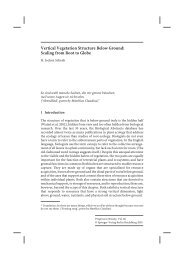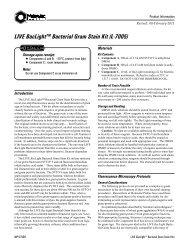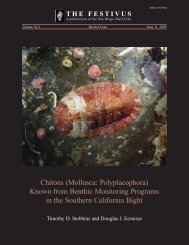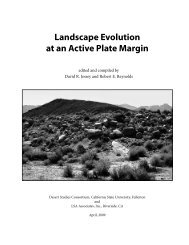2010 Overboard in the Mojave - Biological Science - California State ...
2010 Overboard in the Mojave - Biological Science - California State ...
2010 Overboard in the Mojave - Biological Science - California State ...
Create successful ePaper yourself
Turn your PDF publications into a flip-book with our unique Google optimized e-Paper software.
on <strong>in</strong>land lakes, such as <strong>the</strong> Salton Sea, Imperial County.<br />
The rema<strong>in</strong><strong>in</strong>g species frequent coastal mar<strong>in</strong>e waters or<br />
<strong>in</strong>land areas from <strong>the</strong> San Joaqu<strong>in</strong> Valley, central <strong>California</strong><br />
northward (Pyle, 1961; Cogswell and Christman,<br />
1977; Garrett and Dunn, 1981) (Table 2).<br />
Extant species of migratory birds represented <strong>in</strong> <strong>the</strong><br />
assemblage are presently absent from sou<strong>the</strong>rn <strong>California</strong><br />
dur<strong>in</strong>g <strong>the</strong> summer (Pyle, 1961). They migrate northward<br />
<strong>in</strong> <strong>the</strong> spr<strong>in</strong>g follow<strong>in</strong>g <strong>in</strong>land portions of <strong>the</strong> north–<br />
south Pacific Coast fly-way. Dur<strong>in</strong>g Pleistocene pluvial<br />
periods, this fly-way would have <strong>in</strong>cluded <strong>the</strong> lakes of <strong>the</strong><br />
Colorado and <strong>Mojave</strong> Deserts, those east of <strong>the</strong> Sierra<br />
Nevada Mounta<strong>in</strong>s, and <strong>the</strong> western part of Lake Lahontan<br />
(Snyder et al., 1964). Many of <strong>the</strong>se species are also<br />
known from <strong>the</strong> late Pleistocene deposits of Ch<strong>in</strong>a Lake,<br />
Inyo County, <strong>California</strong>, and Fossil Lake, Lake County,<br />
sou<strong>the</strong>astern Oregon ( Jefferson, 1985b).<br />
Two-thirds of <strong>the</strong> extant species (Gavia arctica,<br />
Podiceps nigricollis, Aechmophorus occidentalis, Pelecanus<br />
erythrorhynchos, Phalacrocorax auritus, Mergus merganser,<br />
Haliaeetus leucophalus, Aquila chrysaetos, and Larus spp.),<br />
represented by 80% NISP of <strong>the</strong> fossil avian specimens<br />
(Table 3), presently prefer or feed exclusively on small<br />
fish (Cogswell and Christman, 1977; Garrett and Dunn,<br />
1981). Gila bicolor mojavensis represents an abundant<br />
food source for <strong>the</strong>se predators. Modern representatives<br />
of <strong>the</strong> rema<strong>in</strong><strong>in</strong>g taxa (Cygnus columbianus, Branta<br />
canadensis, Anas crecca, Anas platyrhynchos, Aythya sp.,<br />
Oxyura jamaicensis, Fulica americana, Grus sp., Actitis sp.),<br />
feed on a variety of water plants and freshwater <strong>in</strong>vertebrates<br />
(Cogswell and Christman, 1977; Garrett and<br />
Dunn, 1981). The owl, Bubo virg<strong>in</strong>ianus, is <strong>the</strong> only bird <strong>in</strong><br />
<strong>the</strong> assemblage that feeds primarily on small mammals.<br />
Mammalian herbivores<br />
Among <strong>the</strong> larger herbivores, three taxa of ground sloth,<br />
Megalonyx, Paramylodon, and Nothro<strong>the</strong>riops, are present.<br />
All are poorly represented <strong>in</strong> <strong>the</strong> assemblage (Table<br />
4). Megalonyx is known from <strong>the</strong> West Coast and eastern<br />
two-thirds of <strong>the</strong> United <strong>State</strong>s, and ranged from South<br />
America <strong>in</strong>to Canada and Alaska. Stock (1925) suggested<br />
that this animal was adapted to forest or woodland habitats.<br />
The habitat and dietary preferences of Paramylodon,<br />
which also ranged through North and South America, are<br />
not well known. Given its association with o<strong>the</strong>r presumed<br />
grassland animals, Stock (1925, 1930) ma<strong>in</strong>ta<strong>in</strong>ed<br />
that Paramylodon was a grazer. Based on analysis of <strong>the</strong><br />
feed<strong>in</strong>g mechanism <strong>in</strong> Paramylodon, Naples (1989) argued<br />
that it was a grazer-browser. Consider<strong>in</strong>g <strong>the</strong> varied<br />
environments with<strong>in</strong> an extensive geographic range, both<br />
Megalonyx and Paramylodon were probably mixed feeders.<br />
Nothro<strong>the</strong>riops shastensis ranged throughout <strong>the</strong><br />
george t. jefferson<br />
southwestern United <strong>State</strong>s and nor<strong>the</strong>rn Mexico. It is<br />
well represented <strong>in</strong> cave assemblages from nor<strong>the</strong>astern<br />
<strong>California</strong> through sou<strong>the</strong>rn Nevada, and Arizona<br />
where it browsed on desert shrubs and plants typical of a<br />
juniper-sage brush savannah habitat (Mart<strong>in</strong> et al., 1961;<br />
Hansen, 1978). This selective folivore/browser (Naples,<br />
1987) appears to have <strong>in</strong>habited a broad spectrum of<br />
floral assemblages, but was limited latitud<strong>in</strong>ally and altitud<strong>in</strong>ally<br />
by m<strong>in</strong>imum w<strong>in</strong>ter temperatures (McDonald et<br />
al., 1996).<br />
Lepus sp. is <strong>the</strong> only small mammalian herbivore well<br />
represented <strong>in</strong> <strong>the</strong> assemblage. Jack rabbits typically <strong>in</strong>habit<br />
grassy and brush covered areas. The order Rodentia<br />
is represented by a s<strong>in</strong>gle cricetid humerus.<br />
The relatively abundant but fragmentary rema<strong>in</strong>s of<br />
mammoth can not be identified to species. However, <strong>the</strong>y<br />
probably represent <strong>the</strong> well-known middle and late Pleistocene<br />
form, Mammuthus columbi (= M. imperator). M.<br />
columbi ranged throughout <strong>the</strong> United <strong>State</strong>s and likely<br />
browsed and/or grazed (Davis et al., 1984) <strong>in</strong> small herds<br />
similar to extant elephants. Evans (1961) suggested that<br />
juvenile mammoths were <strong>the</strong> favored prey of <strong>the</strong> scimitartooth<br />
cat, Homo<strong>the</strong>rium serum. The American mastodon,<br />
Mammut americanum, is absent <strong>in</strong> <strong>the</strong> assemblage, and has<br />
not been identified from any Rancholabrean LMA sites<br />
with<strong>in</strong> <strong>the</strong> <strong>Mojave</strong> Desert or Colorado Desert regions<br />
( Jefferson, 1991c).<br />
Fossil horses are well represented <strong>in</strong> <strong>the</strong> assemblage<br />
(Table 4), and at least two forms, Equus conversidens and<br />
Equus sp. (large) have been identified. The occurrence<br />
Table 4. Relative abundance of mammalian taxa,<br />
Manix Formation<br />
Taxon NISP % NISP<br />
Megalonyx sp. _ 1 0.1<br />
Nothro<strong>the</strong>riops sp. cf. N. shastensis _ 2 0.3<br />
Paramylodon sp. _ 1 0.1<br />
Mammuthus sp. _ 37 5.2<br />
Lepus sp. 11 1.6<br />
Cricetidae 1 0.1<br />
Canis sp. cf. C. dirus _ 5 0.7<br />
Canis latrans 5 0.7<br />
Arctodus sp. _ 1 0.1<br />
cf. Ursus sp. 1 0.1<br />
Felis (Puma) sp. 3 0.4<br />
Homo<strong>the</strong>rium sp. cf. H. crenatidens _ 1 0.1<br />
Homo<strong>the</strong>rium sp. cf. H. serum _ 2 0.3<br />
Equus conversidens _ 52* 7.4<br />
Equus sp. (large-size) _ 67* 9.5<br />
Camelops sp. cf. C. hesternus _ 371 54.7<br />
Camelops sp. aff. C. m<strong>in</strong>idokae _ 5 0.7<br />
Hemiauchenia macrocephala _ 117 16.6<br />
Antilocapara sp. 2 0.3<br />
Ovis canadensis 17 2.5<br />
Bison sp. cf. B. antiquus _ 1 0.1<br />
Note: Total number of identified specimens is 703, and total % NISP is<br />
101.5. Data are <strong>in</strong> part from Jefferson (1985a, 1987).<br />
NISP = number of identified specimens<br />
% NISP = number of specimens identified for each taxon divided by <strong>the</strong><br />
total number of identified specimens<br />
* = may represent more than one species _ = ext<strong>in</strong>ct taxon<br />
48 <strong>2010</strong> Desert Symposium
















